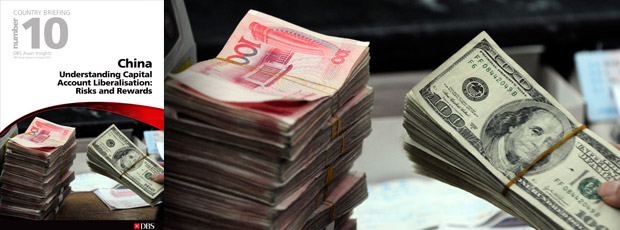08/12/2015
China / GDP

Various promising developments point to Chinese capital accounts being “basically” open in the next five years, dramatically impacting both the Chinese and the global financial landscapes.
China’s capital account convertibility strategy was first put forward in the early 1990s. The process was interrupted by the Asian Financial Crisis of 1997, but the 2008 Global Financial Crisis provided Beijing with a new window of opportunity. The shortage and increased volatility of major currencies led to a rise in the global demand for the Chinese yuan, a situation that led China to facilitate its usage in cross-border trades and investments.
Today, China recognises the many benefits of capital flow liberalisation as a key development driver. Removing restrictions on outflows not only enables companies and households to distribute their large pools of savings in overseas investments, it also allows China’s financial system to channel its inflows into deeper and more diversified sources of capital for borrowers. Meanwhile, greater balance-sheet diversification strengthens the resilience of Chinese banks against system-wide shocks.
As Chinese authorities step up their liberalisation efforts, much can be learned from other countries’ past experiences with the process. In Chile and Thailand, for instance, the opening of capital accounts led to exchange rate and banking crises. The two cases demonstrated that a certain number of preconditions – a stable macroeconomic environment, a sound banking system, and developed financial markets – are needed for a successful capital account liberalisation process.
These past few years, various encouraging developments have been shaping favourable preconditions. In September 2013, the State Council authorised the establishment of the China (Shanghai) Pilot Free Trade Zone (FTZ), the first of its kind in mainland China. It was announced in April 2015 that the FTZ would be expanded to include financial, logistics, transport, and technological clusters. In April 2014, the Shanghai-Hong Kong Stock Connect was successfully launched to allow residents of mainland China to trade shares in Hong Kong and foreigners to invest in Chinese companies. The programme effectively created a single Chinese stock market – one of the world’s largest by market cap and daily turnover – and is now leading to other similar connection schemes.
The continuous expansion of the “Q” programmes, the Qualified Foreign Institutional Investor (QFII) and the Renminbi Qualified Foreign Institutional Investor (RQFII), also shows Beijing’s long-term commitment to the opening of the country’s capital account. Most significantly, the recent institution of a nationwide deposit insurance scheme indicates that interest rates will be fully liberalised in the near term, a move that should pave the way for further reforms.
All of these promising developments point to Chinese capital accounts being “basically” open in the near future, a scenario that in all likelihood will dramatically alter both the Chinese and the global financial landscapes given China’s size and influence.
Read the full report




